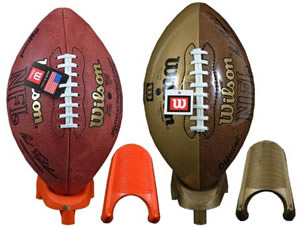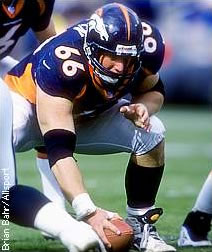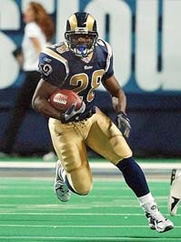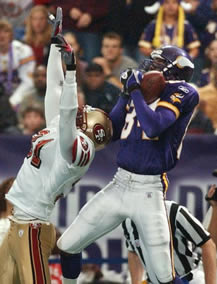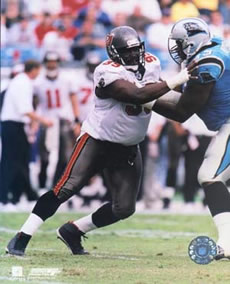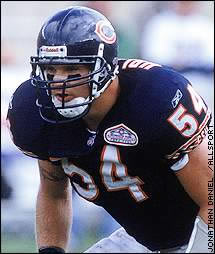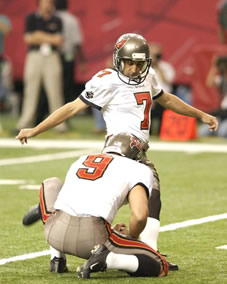American Football is a sport that got its roots in the 19th century's rugby and soccer. These two sports were played in England during the 19th century and were then exported and developed in the United States where they were mixed up together.
 - A 19th century picture representing the idea of football in those times-
- A 19th century picture representing the idea of football in those times-
The main differences between the new-born football and the European games were that instead of playing with a round ball, Americans opted for an egg-shaped one and some rules were changed. After that, an organization called the Intercollegiate Football Association (IFA) was created to preside over the Americanized sport.
This new sport soon got a big success. Initially played by many north-eastern colleges, it was considered as a varsity sport also by Harvard and Yale Universities.
Football was still mainly American rugby - very different from the sport played today.
In 1885, after a three-year course, Yale player Walter Camp finally convinced IFA to change some football rules, creating a game that is very similar to the one played today. Thanks to that, Camp is considered as the father of modern football.
Through the 1800's college football league was the only high-level championship until the beginning of the twentieth century, when professional football teams began appearing. By that time, college sports fell under the newly-established National College Athletic Association (NCAA).
 - The NCAA new era football logo -
- The NCAA new era football logo -
The rules of professional football were derived from the collegiate organization's guidelines.
During the 1920’s, there were more than 10 professional teams across the United States. Organizers from all these teams decided to meet in Canton, Ohio, to form the American Professional Football Association (APFA), which later became the National Football League (NFL).
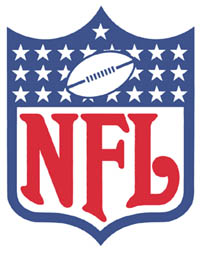 - The NFL logo -
- The NFL logo -
After that, American football became an all-American hyped sport, drawing people and economical interests. As it happened, many leagues tried to establish new franchises, following the NFL’s experience.
However, NFL was so dominant that, after a few years, only the American Football League AFL got by.
Struggling to survive, after some time, this league started acting a rival role on the NFL scene challenging for players' drafting, television contracts and other gains generated from the popularity of the sport.
In many of these situations the NFL overcame the AFL and ended by taking it over in 1970 when the two teams merged together keeping the NFL name.
Finally, to let the NFL mirror its origins, two conferences were created in the league: the American Football Conference AFC and the National Football Conference NFC.
American football is played by two teams; both have eleven players on the field, who face each other to gain yards on the court trying to carry the ball in the opposite end zone.
The football field is divided into two halves and measures 120 yards in length, adding the 100-yard-court and the two 10-yard-long end zones.
 |
- A picture representing a typical football field with the two end zones, a 100-yard court and the side and end lines at its extremities - |
At the extremities of both the end zones two goals are placed (see picture below); they are used as targets for the field goals.
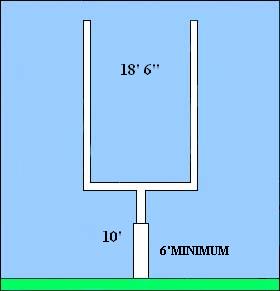 |
- Picture of a goal: maximum height = 30' space between the uprights = 18'6” high horizontal crossbar = 10' minimum height of the goal pads = 6' - |
The home team shall have 36 balls for outdoor games and 24 for indoor games. These can be tested with a pressure gauge by the referee two hours before the game time.
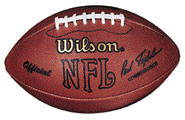 |
The football consists of an inflated rubber bladder encased in a leather or rubber cover. The ball is an extended spheroid, having a circumference of 28.5 in (72.4 cm) around the long axis and 21.25 in (54 cm) around the short axis. It weighs between 14 and 15 oz (397 and 425 g). |
Twelve (12) new footballs, packed in a special box and shipped by the manufacturer, will be opened in the officials' locker room two hours prior to the starting time of the game. These balls are marked with the letter "k" and used only for the kicking games.
| - Kicking balls with tees - |
|
To protect themselves from hurts and contacts with the football, players wear equipment made of lightweight plasticized padding used to cover their thighs, hips, shoulders, knees, forearms and hands. Players also wear plastic helmets with guards that cover most of their faces.
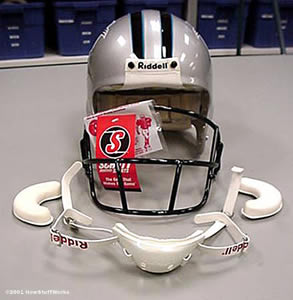
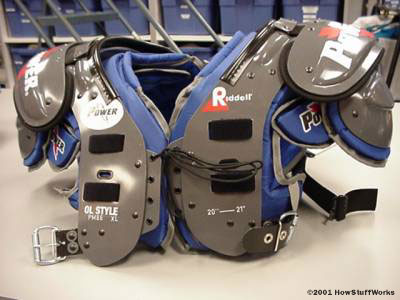
- Player's helmet - shoulder pads -
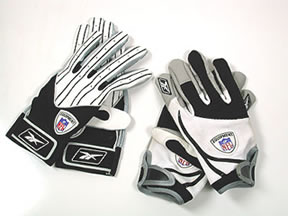
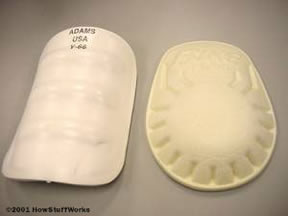
- Gloves - thigh and knee pads -
A roster is generally made up of three teams: the offense, the defense and the special team; each of these is composed of eleven players and goes downcourt in different parts of the game.
The offense is lined up on the field attempting to conquer yards, the defense has to stop the opposite team and the special team is used in particular situations of the game.
A roster is generally made up of three teams: the offense, the defense and the special team; each of these is composed of eleven players and goes downcourt in different
parts of the game.
The offense is lined up on the field attempting to conquer yards, the defense has to stop the opposite team and the special team is used in particular situations of the game.
The match lasts for 60 semi-effective minutes and is divided into two halves and four quarters.
In order to reach the opposite end zone, every team has got 4 attempts (downs) to gain 10 yards, starting from the point where the ball was placed initially, to the yard where it is at the end of the play.
The team that goes past the 10-yard marker gets a first down and another set of tries.
On the contrary, if after 4 attempts a team cannot get a first down, the ball possession changes.
The fourth down, which is the final try, can be used for getting a first down, trying to pass the 10-yard limit, kicking a field goal or getting a punt.
The purpose of the game is to score points; a touchdown scores 6 points and consists in carrying the ball into the end zone, stepping there with both feet.
The touchdown gives also the possibility of gaining extra points: 1 with a field goal from the
20 yards, 2 with the two-point conversion. This is an offensive action from the 2 yards, with the purpose of getting into the end zone.
Another way to score consists in converting a field goal attempt that gives 3 points: the kicker aims to get the ball between the uprights of the opposite goal.
The last scoring method is called safety: a team gets the 2 safety point when, during its defensive action, it tackles an opposite player in his own end zone.
The team that receives a safety gets also the possession in the next kick-off, which starts the two halves and the after-scoring actions.
The line-up which scores the more after 60 minutes wins the game; if after the regular time the two teams are tied up, the game goes into overtime ruled by the “sudden death”.
The one that scores first wins.
It is generally played by the offensive team, rushing or passing the ball; these are the 2 ways allowed to earn yardage.
In the rushing actions the ball is carried ahead by a player lined up in the backfield who tries to go as far as he can in the way to the opposite end zone, taking advantage of his team-mates’ blocks.
In the passing games, in opposition, the ball is thrown to a receiver; this type of actions is complete only if the receiver is able to catch the ball landing with both his feet on the court.
If the pass and the run are not timed perfectly, the ball can bounce aground, be stripped away by a defender or get out of bound; in these situations the passage is incomplete and 1 down is lost.
There is also the possibility for the offense of losing the ball definitively: if a defender is able to catch the ball falling on the court, he goes for an interception.
The players of the offensive team are:
• QUARTERBACKS
• LINEMEN
• BACKFIELD MEN
• RECEIVERS
• TIGHT ENDS
Quarterback: is the main member of the offense, he is the guy who touches every played ball deciding which games to play in the huddle and yelling audible before the snap.
His role is to throw the ball to the wide open receiver or to pass a handoff to the rusher, but it also involves team leading and handling pressure.
Another way to score consists in converting a field goal attempt that gives 3 points: the kicker aims to get the ball between the uprights of the opposite goal.
The last scoring method is called safety: a team gets the 2 safety point when, during its defensive action, it tackles an opposite player in his own end zone.
The team that receives a safety gets also the possession in the next kick-off, which starts the two halves and the after-scoring actions.
The line-up which scores the more after 60 minutes wins the game; if after the regular time the two teams are tied up, the game goes into overtime ruled by the “sudden death”.
The one that scores first wins.
- Michael Vick, gifted and skilled quarterback of the Atlanta Falcons throwing the ball with his left. |
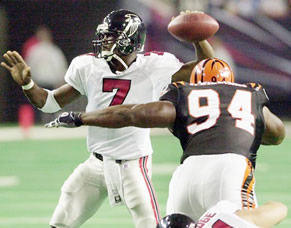 |
Sometimes, if the defense is not prepared, he can also run ahead to gain yards.
He is lined up back with respect to the centre C which passes him the ball with the snap, starting the action.
Abbreviation: QB
Jersey #: from 1 to 19
Linemen: are generally five and play on the line of scrimmage, the imaginary line where the ball is placed before the snap that goes from side to side dividing offense and defense.
The linemen are labelled as:
• TACKLES: are generally two, the left tackle LT and the right tackle RT, lined up at the tips of the offensive line.
• CENTRE: role played by a single player who works in the middle of the offensive line.
• GUARDS: are generally two, left guard LG and right guard RG, lined up either side of the center.
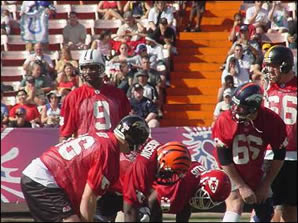 |
- The offensive line is settling down ahead of the quarterback during a training session - |
These players have various tasks during a single game: at first, to get the action started, the centre snaps the ball to the quarterback; after that in the rushing games they should block the defenders, creating room to run.
|
|
On the contrary, during a passing action they have to protect the quarterback preventing the defense from trying to stop the offensive flow and giving the passer the time required for a good throw.
Sometimes a team happens to need more hands to catch the ball on the offense; in these situations they get a lineman elected, declaring to the referee and the opposite team their intention to use him as a receiver.
Abbreviations: LT, LG, C, RG, RT.
Jersey #: from 60 to79.
Backfield men: most commonly called running backs RB; they are settled down in back of the quarterback, in the backfield and are labelled as:
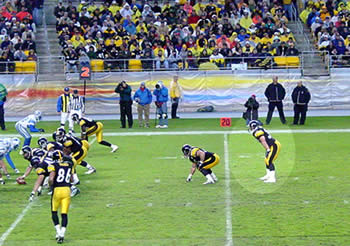 |
- The picture shows clearly where the two running backs line up. |
• HALFBACK: is the first option runner in a team, handling the ball rushing. This player has to be fast but also a little strong, he has to face hard tackles and hurts; he can always be used also as an added receiver.
|
- Marshall Faulk, Halfback of the St. Louis Rams during a rushing action. |
• FULLBACK: generally placed before the halfback, his work involves blocking for the runners, rushing to gain short and well-defended-yards and receiving.
This player must have more strength and weight than the halfback, sacrificing his agility a little.
The placement of these two players in the backfield is not always the same, their position changes depending on the type of formation lined.
Abbreviation: RB labelled as HB and FB.
Jersey #: from 20 to 49.
Wide receviers: are generally two, lined up 10-15 yards wide of the offensive line.Their work is to receive the QB’s throws in the passing actions, handling the ball and aiming for a touchdown; they also support the running games by blocking defenders.
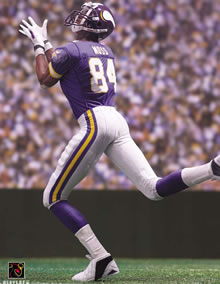 |
|
He jumped over the defender anticipating him. -
Abbreviation: WR
Jersey #: from 80 to 89.
Tight end: this player can be seen as an added lineman, but always elected.
As a matter of fact he can always receive a throw.
His lining up on the court, at the end of the left or right side of the offensive line sets the strong side.
Abbreviation: TE
Jersey #: from 80 to 89.
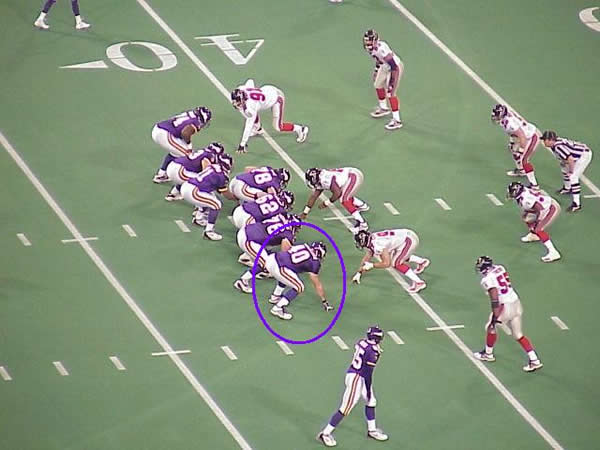
Singleback normal |
|
| Goal line normal | 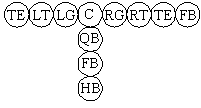 |
| Split backs-normal | 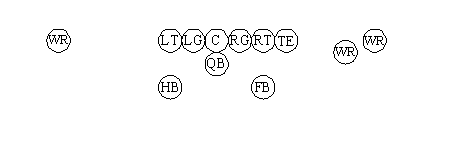 |
| I-formation | 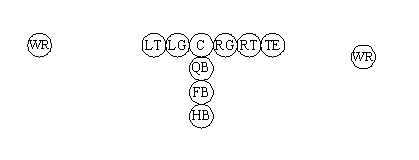 |
| Shotgun | 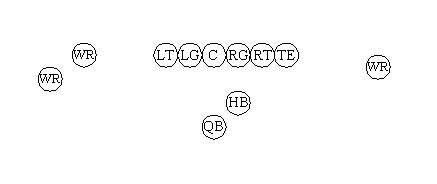 |
The defense is generally played by the defensive team, which attempts to prevent scoring opportunities by stripping or intercepting offensive throws, tackling runners or sacking the opposite quarterback.
The defensive team is made up of:
• DEFENSIVE LINEMEN
• LINEBACKERS
• DEFENSIVEBACKS
Defensive linemen: these players are generally three or four depending on the type of defense used (3-4, 4-3), lined up on the line of scrimmage.
They are labelled as:
• Defensive tackle: there can be one or two of these, lined up on the line of scrimmage;
In the 3-4 formation the DT is only one and is called nose tackle (NT); in opposition, in the 4-3 formation the DT are two.
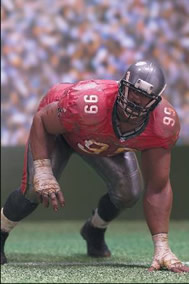 |
|
-Warren Sapp, defensive tackle of the Tampa Bay Buccaneers- |
• Defensive ends; are two, lined up at the two side ends of the defensive line
The first function of the linemen is to face up the opposite offensive line, avoiding blocks and making pressure on receiving backs or quarterbacks, in particular with the Des.
Abbreviation: DT or NT, DE.
Linebackers: are three or also four, depending on whether the formation is a 3-4 one or a 4-3 one, lined up 2 or 3 yards back of the defensive line. On the first type of defense there are four linebackers, two outside and two inside linebackers (OLB, ILB).
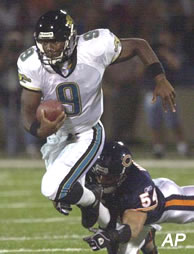 |
|
In opposition, with a 4-3 defense, there are two outside linebackers and a single middle linebacker.
The role of the linebacker is the main one on the defense: he decides every defensive play in the huddle and balances the defense with audible plays before the snap.
Their tasks on the field are to stop runners, cover receivers and sometimes also to rush the opposite quarterback with a blitz play.
Defensive backs: they line up in the back side of the defense and are labelled as:
• Cornerbacks: generally two, lined up in opposition to the wide receivers, they should cover them and sometimes provide support in stopping rushing games.
• Safeties: generally two, lined up 8-10 yards in back of the line of scrimmage. In particular, the safety lined on the strong side of the offense takes the name of strong safety SS and the other is called free safety FS.
Their work is to cover throws, in particular denying every long pass attempted by the defense.
Defensive backs are generally four in the basic formations (3-4, 4-3), but in particular situations they can become 5 in the nickel defense or 6 in the dime defense.
Zone and man defense: These are the 2 types of defense that are commonly used.
In the zone defense, all the guys on the court but the linemen should cover a particular zone, stopping rushes or intercepting throws.
In this type of defense there is an important rule: a defender is not allowed to touch a receiver before he catches the ball. On the contrary, if it happens, the referee calls a pass interference.
In the man defense, on the contrary, every guy should cover a particular man.
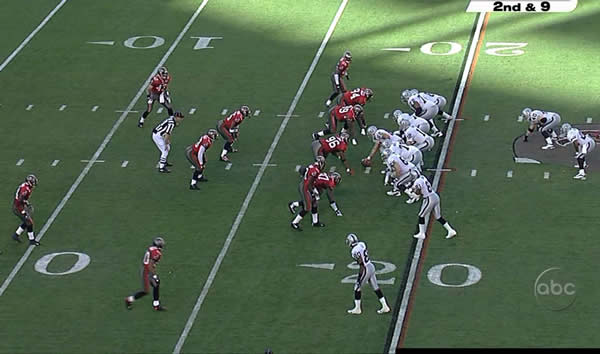
- This picture shows the Tampa Bay Buccaneers (red jersey) lined up defensively probably with an adjusted nickel -
Goal line |
|
| Dime | 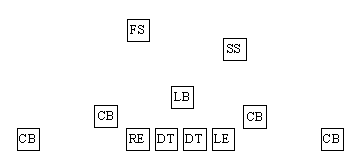 |
| Nickel | 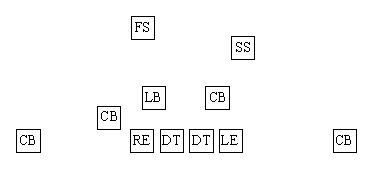 |
| 3/4 |  |
| 4/3 |  |
| 46 |  |
The special team is made up of eleven players and is responsible for kicking, returning or punting.ense is not prepared, he can also run ahead to gain yards.

- A 33-yard field goal attempt, in this picture the kicker, the farthest man in the backfield can be clearly seen -
K (Kicker) – is the player who kicks the ball off from a tee or aground with a holder that takes it.
|
|
P (Punter) – is the player who punts the ball. Lined up 10-13 yards back of the long snapper, receives the ball and drops it.
Holder – is lined up 8 yard back of the long snapper, receiving the snap and maintaining the ball in position for the kick. Role generally played by the second quarterback or by the punter.
Long Snapper – is lined up in the middle of the offensive line and snaps the ball with a long pass.
PR/KR (Punt/Kick Returner) – is the player that receives the punts and the kicks. After the catch he should carry the ball ahead avoiding defenders, aiming to the end zone. Role generally played by a receiver or cornerback.
Special teams

